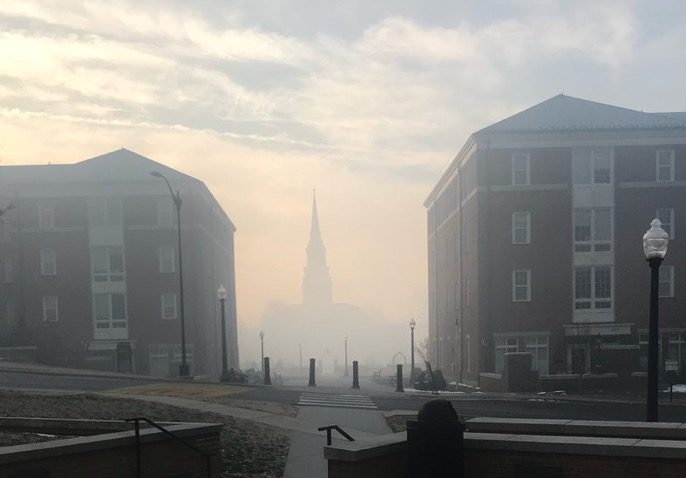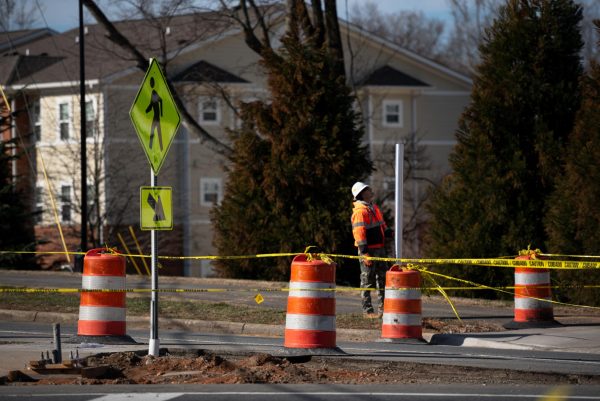Explaining the Weaver Fire
Smoke covers the view of Wait Chapel from Polo Residence Hall in Feb. 2, 2022.
On Monday night, shortly before 7 p.m., a fire started blazing on a loading dock at the Weaver Fertilizer Plant on North Cherry St., according to reporting from the Winston-Salem Journal. Winston-Salem Fire Chief William “Trey” Mayo explained during a news conference shortly after 9 a.m. Tuesday morning that firefighters arrived on the scene at 6:45 p.m., and attempted to contain the fire for the following hour and a half before ceasing.
\
Mayo also reported that there were 500 tons of ammonium nitrate and 5,000 tons of finished fertilizer were at the site when the fire began. Another 100 tons of ammonium nitrate were in a railcar adjacent to the site.
This caused emergency crews to leave the fire and move their equipment away at about 8:30 p.m. in fear of a potential explosion. At about the same time, the Winston-Salem Fire Department issued a voluntary evacuation order for residents within a one-mile radius of the fire. An estimated 6,000 people have been evacuated from the area at this time.
The Winston-Salem fire department, with the aid of drone equipment, documented several smaller explosions throughout the evening within the Weaver Plant building, according to reports from WFMY News 2. Some of the blasts could be felt as far as Deacon Place.
“Our house shook with the explosion,” an anonymous junior told the Old Gold & Black last night.
Nearly two hours later, Wake Forest University released an email urging residents within the one-mile radius to evacuate their residences, including students living in the Deacon Place apartment complex. Shortly after midnight, the university announced that classes would be canceled in an email and advised students to “stay indoors and keep their windows closed”.
In an email on Tuesday morning at 11:13 a.m., the university’s administration addressed the faculty, staff and students, writing that they believe that there is “no threat to campus at this time”, and advising students, faculty and staff to relocate “as quickly as possible”.
According to the administration, there are about 1,000 students, faculty and staff that reside within the one-mile radius. The university is offering help with evacuation for students through the department of residence life and housing. Winston-Salem officials have also opened a shelter at the Winston-Salem Fairgrounds.
One of the reasons that the fire has caused concern — and national news coverage — is because fertilizer fires have been known to wreak havoc on communities. In the summer of 2020, over 2,700 tons of fertilizer exploded in Beirut, Lebanon, killing over 200 people. In a 2013 West Texas explosion, 240 tons of fertilizer exploded, killing 15 people. Large-scale agriculture operations across the United States house considerable amounts of ammonium-nitrate, a synthetic fertilizer. The Weaver fertilizer plant contained 600 tons of ammonium nitrate.
Dr. Stan Meiburg, director of graduate studies in sustainability at Wake Forest University, was optimistic about the air quality outside of the one-mile radius. Meiburg served as the EPA’s Acting Deputy Administrator from 2014 to 2017, capping his 39-year career with the agency.
“The reported concentrations of nitrous oxide outside of the one-mile radius area seem to be under the level of short-term concern,” Meiburg said. “If the ammonium nitrate had been concentrated in the way that it had been in West Texas, there would have been a larger incident already.”
A byproduct of the fire’s smoke is nitrous oxide. According to the CDC, nitrous oxide can be classified as a respiratory irritant, which in low concentrations may cause mild shortness of breath and cough.
Meiburg emphasized the need for faculty, staff and students to follow the advice of local public health authorities and praised the efforts of Winston-Salem’s first responders.
“The Incident Command, who is the Winston-Salem Fire Chief, has handled the situation well,” Meiburg said. “The EPA [responders] will arrive and monitor the air quality both inside and outside the one mile radius.”
Meiburg also explained that the weather conditions allowed for the smoke to drift near Wake Forest’s campus.
“The prevailing wind caused the plume from the fire to drift toward the Southwest, roughly following the line of Polo Road,” Meiburg said. “An inversion layer, which is warm air on top of cold air, caused smoke from the plume to stay nearer to the ground overnight. As the sun heated up the air, during the day, the inversion layer lifted, allowing the smoke to disperse more widely throughout the atmosphere.”
Mayo said during a news conference on Tuesday morning that the Greensboro Fire Department had arrived late Monday night and began monitoring the air quality outside of the one-mile radius and reported that there is no cause for concern.
“The threshold for immediately dangerous to life and health is 100 parts per million of nitrous oxide,” Mayo said. Around 9 a.m on Tuesday, air reports read 65 parts-per-million of nitrous oxide outside of the one-mile radius.
In a press conference Tuesday afternoon, Mayo reiterated the severity of the situation.
“There were 240 tons of ammonium nitrate on site [in Texas],” Mayo said. “There are 600 tons on site here. If that doesn’t communicate the gravity of the situation, I don’t know how to verbalize that.”

Connor McNeely is a senior and hot-tub enthusiast from Mooresville NC, majoring in English with a minor in Politics & International Affairs....

Cooper Sullivan is a senior from Winston-Salem majoring in Communication with double minors in Journalism and Art History. He enjoys...

Aine is a senior from Cherry Hill, N.J. She is a history major with minors in journalism and sociology. When not in the OGB office, you can find her watching...

Una is a senior from Winston-Salem, North Carolina who is majoring in Biology with minors in environmental studies and journalism. Outside of the OGB,...












